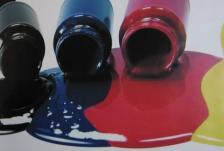
custom printing inks
Printing inks must be transported from a reservoir and then in a printing-process-specific manner onto the substrate. The ink transfer can take place through:
- ink splitting (offset, gravure, and letterpress printing): inking rollers, printing plate, and blanket (in offset) transfer/transport the ink film;
- direct ink film transfer from a base foil onto the substrate (hot embossing, thermo transfer);
- pressing the ink through openings (screen printing);
- spraying on the ink in the form of droplets without making direct contact with the substrate (ink jet).
The inks must dry or cure on the substrate. Here, differentiation is basically made between physical (absorption, evaporation) and chemical drying (oxidation, radiation curing) procedures. Very often a combination of the drying processes is applied. Solidification drying represents a special characteristic whereby inks are fluid in a hot state and then solid after cooling, for instance, hot embossing The ink must have good adhesion to the substrate.
Several methods are common (also combinations):
- The ink anchors mechanically to the substrate surface (penetrating into pores, encasing paper fibers); here, a certain pressure between ink carrier (e.g., blanket for offset printing processes) and substrate is required and/or
- The ink penetrates into the substrate surface by capillary action (e.g., ink jet).
- In the case of extremely smooth surfaces, the ink is held by means of polar interaction (chemical/physical effects) between the ink and substrate.



















